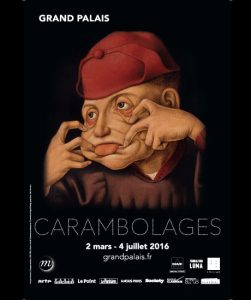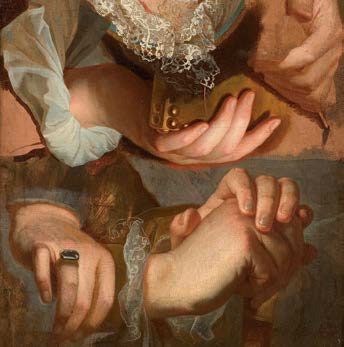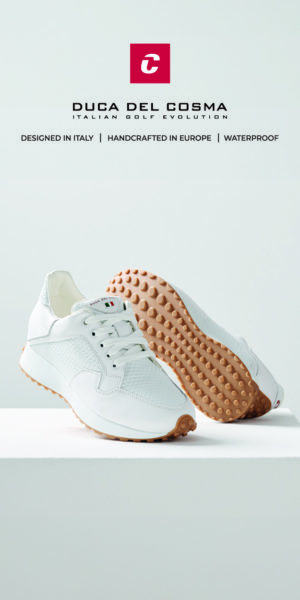Posted on April 28, 2016 in Agenda, Arts & culture.
Carambolages: exhibition from March 2 to July 4, 2016 at the Grand Palais
 Jean-Hubert Martin offers an original exhibition with an innovative concept: decompartmentalizing our traditional approach to art, transcending the boundaries of genres, eras or cultures and speaking to everyone's imagination.
Jean-Hubert Martin offers an original exhibition with an innovative concept: decompartmentalizing our traditional approach to art, transcending the boundaries of genres, eras or cultures and speaking to everyone's imagination.
The exhibition offers a journey through universal art from a deliberately current point of view. More than one hundred and twenty works, all eras and all cultures combined, are grouped according to their formal or mental affinities. The works presented, often atypical, chosen for their strong visual impact, correspond to contemporary questions or choices, without taking into account the original context.
They are ordered in a continuous sequence, as in a narrative film, where each work depends on the previous one and announces the next. In a journey giving way to visual thought, the pedagogy of the sensitive and the surprises of art, the visitor wanders among the works of Boucher, Giacometti, Rembrandt, Dürer, Man Ray or even Annette Messager.
The artists build up a baggage of visual references drawn from the history of art. Their choice is free and does not follow the logic and categories of knowledge. Their references can be both formal and semantic. For Ingres, Picasso and many others, it is not so much the authenticity of the work that counts as its memory, its obsessive presence and its impact. Many artists constitute collections, like André Breton and the collection of heterogeneous objects that take on meaning on the Studio Wall. The work then draws part of its meaning from what surrounds it. Others have given life to imaginary museums. Daniel Spoerri organized a series of exhibitions entitled "Sentimental Museums", the first version of which was presented at the Center Pompidou in Paris in 1977. The objects are brought together for their ability to evoke and suggest. Affect prevails over aesthetics. The object becomes a living memory for the collective imagination.
The question of a new order to find, which is not that of the history of art and its inevitable
chronology, concerns more and more conservatives. The current of art history embodied by Warburg,
Gombrich and Baltrusaïtis are today finding renewed interest and stimulating studies and exhibitions. Their cross-cultural conception of art - their broad approach that does not stop at learned art and their use of comparativism - serves, as much as the example of the artists, as a basis for reflection for this project.

Hyacinthe Rigaud, Study of hands (detail), 1715-1723, oil on canvas, 53,5 x 46 cm, Montpellier, Musée Fabre
© Fabre Museum of Montpellier Méditerranée Métropole - photography Frédéric Jaulmes
This open-plan conception of the assembly of works, obeying criteria that are not exclusively historical, is very often found in private collections of yesterday and today. The museum has opposed its space-time order, except in a few cases where donors have demanded that their presentation be fully preserved, for example the Soane Museum in London, the Pitt Rivers Museum in Oxford, the Condé museum in Chantilly or the Gardner Museum in Boston. These museums are experiencing renewed interest from both the public and experts. All are charmed by the surprises that their presentation holds based on formal or mental affinities.
This exhibition, freed from the thematic principle, addresses all kinds of subjects which are linked according to an associative logic. It is the shaping and expression of a visual thought which constitutes the foundation of artistic creation.
The works presented come from prestigious establishments such as the National Library of France, the Pompidou Center, the Louvre Museum, the National Museum of Asian Arts - Guimet, the Quai Branly Museum or the Barbier-Mueller Museum in Geneva. Their gathering is not intended to immerse the spectator in history but rather to give him an overview of the desires, fears or hopes of humanity that echo his own. If some discoveries should delight insiders, the exhibition aims to address the widest audience, in particular those who have no knowledge of art history, causing shock, laughter and emotion.
Ancient ex-voto, contemporary pieces, western and eastern paintings combine in a sensitive ballet according to a set of visual, analog or semantic correspondences. A fun tracking shot for all audiences.
Pratical information
- Commissioner: Jean-Hubert Martin, art historian
- scenographer: Hugues Fontenas Architect
- opening : every day from 10 a.m. to 20 p.m., nocturnal Wednesday until 22 p.m. - closed Tuesday
- closed on Sunday May 1, 2016
- European Museum Night on Saturday May 21 In 2016: free from 20 p.m. to 1 a.m. (last access midnight)
- prices : € 13, € 9 TR (16-25 years old, job seekers, large families). Tribe rate (4 people including 2 young people 16-25 years old): € 35. Free for children under 16, beneficiaries of the RSA and the minimum retirement age.
- access: metro line 1 and 13 "Champs-Elysées-Clemenceau" or line 9 "Franklin D. Roosevelt"
- information and reservations: www.grandpalais.fr
F1 and golf challenge each other on Netflix, Pierre Gasly versus Justin Thomas
Roche Bobois Pro-Am of Bordeaux: great golf courses, great wines and gastronomy...
Tignes Golf Open: the golf and musical event








